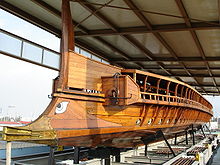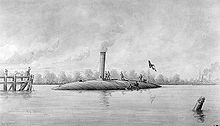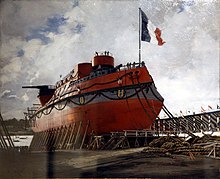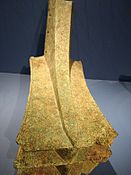Naval ram
This article's lead section may be too short to adequately summarize the key points. (February 2024) |

A naval ram is a weapon fitted to varied types of ships, dating back to antiquity. The weapon comprised an underwater prolongation of the bow of the ship to form an armoured beak, usually between 2 and 4 meters (6–12 ft) in length. This would be driven into the hull of an enemy ship to puncture, sink or disable it.
Antiquity
[edit]It was possibly developed in late Bronze Age Egypt, but it only became widely used in later Iron Age Mediterranean galleys.[1] The ram was a naval weapon in the Greek/Roman antiquity and was used in such naval battles as Salamis[2] and Actium. Naval warfare in the Mediterranean rarely used sails, and the use of rams specifically required oarsmen rather than sails in order to maneuver with accuracy and speed, and particularly to reverse the movement of a ramming ship to disentangle it from its sinking victim, lest it be pulled down when its victim sank. The Athenians were especially known for their diekplous and periplous tactics that disabled enemy ships with speed and ramming techniques.[3]
Rams were first recorded in use at the battle of Alalia in 535 BC.[4] There is evidence available to suggest that it existed much earlier, probably even before the 8th century BC. They appear first on stylized images found on Greek pottery and jewelry and on Assyrian reliefs and paintings.[5] The ram most likely evolved from cutwaters, structures designed to support the keel-stem joint and allow for greater speed and dynamism in the water.[6] Rams were supported by bulkheads, formed by enclosing the bow behind the ram. Instead of using bulkheads to protect ships against ram attacks, Greeks reinforced the hull with extra timber along the waterline, making larger ships almost resistant to ramming by smaller ones.[7]
No later than the 7th century AD, rams were no longer used in the Mediterranean and the knowledge of the design of the ancient triremes had been forgotten. Medieval galleys instead developed a projection, or "spur", in the bow that was designed to break oars and to act as a boarding platform for storming enemy ships. The only remaining examples of ramming tactics were passing references to attempts to collide with ships in order to destabilize or capsize them.[8]
The Athlit ram, found in 1980 off the coast of Israel near Atlit, is an example of an ancient ram. Carbon 14 dating of timber remnants date it to between 530 BC and 270 BC.[9]
Rams are believed to be one of the main weapons of war galleys from around the 6th or 5th century BC, and the Athlit ram's construction implies advanced technology that was developed over a long period of time. Heavy timbers were shaped and attached to the hull, and then the bronze ram was created to fit around the timbers for added strength. The evidence for this lies in the remnants of timbers found inside the Athlit ram when it was discovered. The blunt edge of the ram and the patterned protrusion were intended to break open the seams of the target ship while at the same time dispersing the force of impact on the attacking ship to prevent the ram from twisting off and damaging the attacking ship. It was also less likely to become stuck in the hull of its target.[10]
The Athlit ram consists of a single bronze casting weighing 465 kilograms (1,025 lb).[9] It is 226 centimetres (89 in) long with a maximum width of 76 centimetres (30 in) and a maximum height of 96 centimetres (38 in). The bronze that makes up the shell is a high-quality alloy containing 9.78% tin with traces of lead and other elements. The shell was cast as a single piece to match the timbers it protected.[11] The casting of an object as large as the Athlit ram was a complicated operation at the time, and would have been a considerable expense in the construction of a war galley.
The most likely casting method would have been the lost wax technique, which was commonly used for statues and other large casting during this period.[12] Flaws toward the rear of the casting indicate that it was cast "head down" so the best quality of metal was at the very front of the ram. Voids, bubbles, and insufficient filling in the initial casting were repaired using both "plugs" that were hammered into holes, and "casting on" where a new clay mould was built around the flaws and additional molten metal poured in.
The ram can be divided into roughly three sections: the driving centre, the bottom plate, and the cowl. The driving centre is 30 centimetres (12 in) long and 76 centimetres (30 in) wide.[12] This is the area of the ram that makes contact with enemy vessels in battle. The front wall of the head of the ram has the thickest layer of casting at 6.8 centimetres (2.7 in) for extra protection during battle. The surface of the ram was decorated with several symbols.[13] On both sides, there is an eagle head, a thunderbolt, and a helmet surmounted by an eight-point star. The eagle symbols are similar in dimension, but contain many inconsistencies with each other, whereas the helmet and thunderbolt are highly identical, suggesting they were duplicates made from a primary mold before being made part of the final wax master.[12] The ram was attached with mortise and tenon joints and strengthened with 15-millimetre (0.6 in) oak pegs. The wales and the ramming timber are designed to interlock for extra strength. The bottom of the ram features a mortise cut into the ramming timber to fit the most forward end of the keel which was formed into a 4-centimetre (1.6 in) thick and 10-centimetre (3.9 in) long tenon.[13]
Early modern rams
[edit]In 1727, during the Anglo-Spanish War, Spanish engineer Juan de Ochoa proposed King Philip V his project of the barcaza-espín ("barge-porcupine"). These vessels were effectively floating batteries moved by rows and fitted with multiple naval rams, a main one in its prow and eight smaller around its body, which was the reason behind their name. The project was never built, however.[14]
Steam rams
[edit]

With the development of steam propulsion, the speed, power and maneuverability it allowed again enabled the use of the ship's hull, which could be clad in iron, as an offensive weapon. As early as 1840, the French admiral Nicolas Hippolyte Labrousse proposed building a ram steamship, and by 1860, Dupuy de Lôme had designed an ironclad with a ram.[15] The quick success[16] of CSS Virginia's ramming attack on USS Cumberland at the Battle of Hampton Roads in 1862 attracted much attention and caused many navies to re-think the ram. The first coastal battleship, France's Taureau, was built in 1863, for the purpose of attacking warships at anchor or in narrow straits, and was armed with a ram.[17] Many ironclad ships were designed specifically to ram opponents; in ships of this type, the armour belt was extended forward to brace both sides of the ram to increase structural integrity. Several wooden steamships were purpose-built as rams, or converted from existing commercial vessels, such as General Price.[citation needed]

The theory behind the revival of the weapon derived from the fact that, in the period c. 1860, armour held superiority over the ship-mounted cannon. It was believed that an armoured warship could not be seriously damaged by the naval artillery in existence at the time, even at close range. To achieve a decisive result in a naval engagement, therefore, alternative methods of action were believed to be necessary. As it followed, from the same belief, that a ship armed with a ram could not be seriously damaged by the gunfire of its intended victim, the ram became, for a brief period, the main armament of many battleships. It was observed that the guns placed on the Taureau were there "with the sole function of preparing the way for the ram."[18]

During the American Civil War, both Union and Confederate forces employed ram ships. In 1862, Charles Ellet, Jr. was deployed directly by the Secretary of War, Edwin M. Stanton, to build the United States Ram Fleet, a fleet of ram ships to counter the Confederate River Defense Fleet controlling the Mississippi River. Ellet purchased nine steam powered paddle boats and retrofit them for service as ram ships. The ram ships played an important part in the Union victory during the First Battle of Memphis and helped the Union forces wrest control of the Mississippi River from the Confederate forces.[19]

The frequent use of ramming as a tactic in the Battle of Lissa and, to a lesser extent, at the Battle of Iquique also led to many late 19th-century naval designers equipping their warships with ram bows. This only really aggravated a number of incidents of ships being sunk by their squadron-mates in accidental collisions as ramming never featured as a viable battle tactic again. The fixation on ramming may also have inhibited the development of gunnery.
Toward the end of the 19th century, the breech-loading cannon could effectively hit enemy ships at several thousand yards range, and the ineffectiveness in battle of the ram became clear; ships were no longer fitted with them. Battleships and cruisers instead had inverted bows which superficially resembled rams. These were not, however, reinforced, and were fitted in order to improve ship speed by increasing the waterline length. They also served to decrease the length of forecastle that was exposed to muzzle flash when the guns were fired directly ahead.
No other ironclad was ever sunk by wartime ramming by an enemy ship, although the ram was regarded by all major navies for some 30 years as primary battleship armament. A number of ships were, however, rammed in peacetime by ships of their own navy. The most serious of these same-navy collisions in terms of loss of life was the collision between HMS Victoria and HMS Camperdown, which took place in the Mediterranean in 1893. A total of 358 seamen lost their lives in the incident.[20] However, that death toll was dwarfed by the 562 deaths (plus two rescuers) ensuing from the sinking of the passenger liner SS Utopia, which accidentally collided with the ram bow of the anchored HMS Anson in 1891.[21]
Twentieth century
[edit]
During both world wars, there were several occasions when surfaced submarines were rammed and sunk by surface ships. If successful, such an attack could cut the submarine in two, such as the 1914 sinking of U-15 by HMS Birmingham. The only battleship-over-submarine victory in history occurred during World War I, when the battleship HMS Dreadnought rammed and sank U-boat U-29. Submarines were strongly built to resist water pressure at depth, so the ramming ship could be badly damaged by the attack. This happened to HMS Fairy, which foundered in 1918, after sinking the U-boat UC-75. In March 1943, the destroyer HMS Harvester was badly damaged after ramming the German submarine U-444. She was sunk by another U-boat the next day as she sat helpless, without working engines.[22]
Ramming attacks during the Second World War included the ramming of U405 by USS Borie. The U-boat was not critically damaged and there followed a small-arms battle between the vessels as they were locked together and the U-boat was too close for Borie to bring her main guns to bear. The submarine eventually sank but Borie was too badly damaged by the ramming to be salvaged, so she was abandoned and deliberately sunk by Allied forces.
Other submarines sunk by ramming included U-100, U-224, U-655,[23] the Italian submarines Tembien[24] and Cobalto,[25] the Japanese submarine I-1[26] and the Royal Navy submarines HMS Oswald and HMS Cachalot. The Finnish submarine Vetehinen herself rammed and sank Soviet submarine ShCh-305 on 5 November 1942.
As ramming was the only weapon available to unarmed merchant ships, there were occasions when they attempted to ram U-boats. The British Admiralty in the First World War expected that some merchant captains might try to ram U-boats as much as twice the size of their own vessel and capable of much greater speed, if the situation favoured such a tactic.[27] In 1915, SS Brussels attempted, but failed, to ram U-33. Her captain, Charles Fryatt, was captured by the Germans a year later. He was court-martialled and executed as they considered his act to be that of a franc-tireur. The French steamer Molière sank the U-boat UC-36 in 1917.[28] An old British paddle steamer, Mona's Queen, rammed and sank a U-boat in February 1917.[29] In May 1918 UC-78 was sunk by the steamer Queen Alexandra,[30] and RMS Olympic rammed and sank U-103.[31]
During World War II, U-46 was struck by the British tanker SS Ensis. The submarine survived the ramming but had to return to port for repair.[32] The Italian merchant ship Antonietta Costa rammed and sank submarine HMS Rainbow while on a convoy from Bari to Durazzo.[33] Accidental ramming can also occur during wartime, such as in October 1942 when, during escort duty, the light cruiser HMS Curacoa was accidentally sliced in half and sunk by the significantly heavier (15x) ocean liner RMS Queen Mary, with the loss of 337 men.
On 2 August 1943, Imperial Japanese Navy destroyer Amagiri rammed and sank a smaller, faster, and more maneuverable,[34] United States Navy PT boat, PT-109, commanded by John F. Kennedy.[35] Explosive motor boats which usually detonated after ramming their target were employed by the Italian and the Japanese navies in World War II. Italian type MTM boats rammed and crippled the British cruiser HMS York and a Norwegian tanker at Suda Bay in 1941, while Shinyo suicide motorboats sank a number of US amphibious craft in the Pacific Theatre of operations in 1945.
Late in the century, ramming by major warships became the tactic of choice during the Cod Wars conflict between the Icelandic Coast Guard and the Royal Navy.[36] At least 15 British frigates, five Icelandic patrol boats and one British supply ship were damaged by ramming between 1975 and 1976.[37]
Towing tests of warships found that a below-water ram reduced resistance through the water, which led to the development of a non-reinforced bulbous bow where rams were formerly fitted.[38]
Torpedo rams
[edit]
The torpedo ram is a hybrid torpedo boat combining a ram with torpedo tubes. Incorporating design elements from the cruiser and the monitor, it was intended to provide a small and inexpensive weapon systems for coastal defence and other littoral combat.
Like monitors, torpedo rams operated with very little freeboard, sometimes with only inches of hull rising above the water, exposing only their funnels and turrets to direct enemy fire. They were equipped with torpedoes and guns in turrets. Early designs incorporated a spar torpedo that could be extended from the bow and detonated by ramming a target. Later designs used tube-launched self-propelled torpedoes, but retained the concept of ramming, resulting in designs like HMS Polyphemus, which had five torpedo tubes, two each port and starboard and one mounted in the centre of her reinforced ram bow.
Civilian use
[edit]
Rams have also been used on civilian vessels. The Seattle fireboat Duwamish, built in 1909, was designed to ram burning wooden vessels, as a last resort.[39]
Experimental archaeology
[edit]From 2021 to 2023, a team of nautical archaeologists from Texas A&M University successfully cast an ancient trireme-sized naval ram based on ancient methods. The project consisted of three major steps to replicate the construction process: false bow construction, beeswax model creation, and lost-wax casting. The purpose of the experimental reconstruction was to better understand the time, manpower, and materials needed to create naval rams which helped to understand the economic, social, and political apparatuses of ancient navies. The reconstructed naval ram, called the "DeCasien ram" after its builder Stephen DeCasien, is currently housed at the Center for Maritime Archaeology and Conservation (CMAC) at Texas A&M University.[40]
See also
[edit]- Bulbous bow – Protruding bulb at the front of a ship
- Dolphin (weapon) – weaponized anchor in Ancient Greece
- Inverted bow – Bow whose farthest forward point is not at the top
- Marine archaeology – Archaeological study of human interaction with the sea
- Ramming#Naval warfare – Military combat technique
- Rostra – Ancient Roman platform for speakers
- Rostral column – naval victory column type
References
[edit]- ^ "Britannica: Ram".
- ^ Lazenby, J.F. The Defence of Greece 490–479 BC. Aris & Phillips Ltd., 1993 (ISBN 0-85668-591-7); pp. 34-37.
- ^ Coates, J., J. Morrison, and N. Rankov. The Athenian Trireme: The History and Reconstruction of an Ancient Greek Warship. Cambridge: Cambridge University Press, 2000
- ^ Morrison, Coates & Rankov (2000), pp. 27-30
- ^ Casson, L. "The Ancient Mariners: Seafarers and Sea Fighters of the Mediterranean in Ancient Times." Princeton: Princeton University Press, 1991; pp. 76-77.
- ^ Mark, Samuel. "The Earliest Naval Ram." International Journal of Nautical Archaeology 37:253-272, March 2008.
- ^ Pitassi, Michael (2022). "Chapter 3 | Rams, Towers, Artillery and Tactics". Hellenistic naval warfare and warships 336-30 BC: War at Sea from Alexander to Actium. Barnsley (GB): Pen & Sword Military. p. Chapter 3, 1. ISBN 978-1-3990-9760-4.
- ^ Hocker, Frederick M. "Late Roman, Byzantine, and Islamic Galleys and Fleets". Morrison, John S.; Gardiner, Robert, eds. (1995). The Age of the Galley: Mediterranean Oared Vessels Since Pre-Classical Times. London: Conway Maritime Press. ISBN 0-85177-554-3; pp. 98–99.
- ^ a b Avshalom Zemer. "The Athlit Ram". Haifa Museums. Archived from the original on 18 December 2012. Retrieved 18 October 2011.
- ^ Mark, Samuel. "The Earliest Naval Ram." International Journal of Nautical Archaeology 37:253-272, March 2008
- ^ Mark, S. 2008. "The Earliest Naval Ram" The International Journal of Nautical Archaeology 35: 261-4
- ^ a b c Oron, A. 2001. "The Athlit Ram: Classical and Hellenistic Bronze Casting Technology." MA. Thesis, Texas A&M University
- ^ a b Casson, L., J. Steffy, E. Linder. 1991. The Athlit Ram. College Station: Texas A&M University Press.
- ^ Fernández Duro, Cesáreo (1876). Disquisiciones náuticas, tomo 1. Michigan University.
- ^ Ropp, Theodore, and Stephen S. Roberts. The Development of a Modern Navy: French Naval Policy, 1871-1904. Naval Institute Press, 1987; p. 12.
- ^ Cumberland sank so quickly that it almost brought Virginia down as well.
- ^ Ropp and Roberts, p. 13; Hore, Peter: The Ironclads, page 38. Anness Publishing Ltd, 2006. ISBN 978-1-84476-299-6.
- ^ Ropp, Theodore, and Stephen S. Roberts. The Development of a Modern Navy: French Naval Policy, 1871-1904. Naval Institute Press, 1987; p. 13.
- ^ Laidig, Scott. "The Fighting Ellets: Ingenuity, Courage, Nepotism and Corruption?". www.ehistory.osu.edu. Retrieved 16 August 2020.
- ^ Hough, Richard (1959). Admirals in Collision. London: Hamish Hamilton. pp. 98, 105–06.
- ^ "The Dead of the Utopia" (PDF). The New York Times. 20 March 1891.
- ^ Helgason, Guðmundur. "HMS Harvester (H 19)". uboat.net.
- ^ Helgason, Guðmundur. "U-655". uboat.net.
- ^ Helgason, Guðmundur. "HMS Hermione (74)". uboat.net.
- ^ Helgason, Guðmundur. "HMS Pathfinder (G 10)". uboat.net.
- ^ Waters, Sydney David (1956) The Royal New Zealand Navy, Page 307-309, Historical Publications Branch, Wellington.
- ^ Corkill, Adrian (2013). Hostile Sea. Adrian Corkill. p. 16. ISBN 9780954011529.
- ^ Helgason, Guðmundur. "WWI U-boats: UC 36". German and Austrian U-boats of World War I - Kaiserliche Marine - Uboat.net.
- ^ Ships of the Isle of Man Steam Packet Company (Fred Henry) p.66
- ^ Helgason, Guðmundur. "WWI U-boats: UC 78". German and Austrian U-boats of World War I - Kaiserliche Marine - Uboat.net. Retrieved 23 February 2009.
- ^ Helgason, Guðmundur. "WWI U-boats: U 103". German and Austrian U-boats of World War I - Kaiserliche Marine - Uboat.net.
- ^ Helgason, Guðmundur. "U-46". uboat.net.
- ^ Fontenoy, Paul E. (2007). Submarines: An Illustrated History of Their Impact. ABC-CLIO. p. 282. ISBN 9781851095636.
- ^ Tarantola, Andrew. "PT Boats: The Only Fast Attack Craft Fit for a President". Gizmodo. Retrieved 2018-11-19.
- ^ "John F. Kennedy and PT 109 | JFK Library". www.jfklibrary.org. Retrieved 2018-11-19.
- ^ Evans, Andrew (2008). Iceland: The Bradt Travel Guide. Bradt Travel Guides. pp. 25. ISBN 9781841622156.
- ^ Jones, Robert (2009) Safeguarding the Nation: The Story of the Modern Royal Navy. Seaforth Publishing, p. 119. ISBN 1848320434
- ^ Bertram, Volker; Schneekluth, H. (1998-10-15). Ship Design for Efficiency and Economy. Elsevier. ISBN 9780080517100.
- ^ James Delgado (1988). "Duwamish Fireboat: National Historic Landmark Study". National Park Service. Archived from the original on 2009-05-05.
- ^ "How a Grad Student Built His Own Badass Ancient Naval Weapon". Popular Mechanics. 2023-01-31. Retrieved 2023-02-03.
Further reading
[edit]- Adams, Jonathan R.; Antoniadou, Annita; Hunt, Chistopher O. (2012). "The Belgammel Ram, a Hellenistic-Roman Bronze Proembolion Found off the Coast of Libya: test analysis of function, date and metallurgy, with a digital reference archive" (PDF). International Journal of Nautical Archaeology. 42 (1): 60–75. CiteSeerX 10.1.1.738.4024. doi:10.1111/1095-9270.12001. S2CID 39339094. Archived from the original on 2016-08-28.





